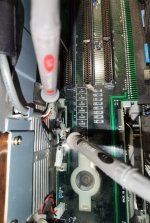cj7hawk
Veteran Member
Hi all,
I think I posted in the wrong forum section previously. I'm repairing a Powermate Portable SX and the Plasma screen stopped working. Is anyone able to measure the voltages from the ground terminal near the Plasma power plug in the ISA slot bay and tell me what they are?
There are 3wires and they could all be up to around 200v DC, so be careful when measuring. You don't need t unplug the display, just measure from the back of the plug itself to the ground terminal spades nearby.
There is a black, a white and a red wire. I need all three with reference to ground. As seen in the two pictures below.

Close up.

I'm getting 5v on Black., -183v on White and -188v on Red ( 5v lower than white ).
I can see all the other signals getting to the display, so am unsure as to why it is not working. I'm Not sure of the display pinouts beyond the video signal and the contrast knob, so if anyone has any schematics or details on the displays in these models, that would also be appreciated. I can figure out the vide signals, but I'm not sure which is the enable line.
Also, my CMOS is reset... If anyone knows where I can get a disk image or the programs to reset it that would also be greatly appreciated -
Thanks and Kind Regards
David
I think I posted in the wrong forum section previously. I'm repairing a Powermate Portable SX and the Plasma screen stopped working. Is anyone able to measure the voltages from the ground terminal near the Plasma power plug in the ISA slot bay and tell me what they are?
There are 3wires and they could all be up to around 200v DC, so be careful when measuring. You don't need t unplug the display, just measure from the back of the plug itself to the ground terminal spades nearby.
There is a black, a white and a red wire. I need all three with reference to ground. As seen in the two pictures below.

Close up.

I'm getting 5v on Black., -183v on White and -188v on Red ( 5v lower than white ).
I can see all the other signals getting to the display, so am unsure as to why it is not working. I'm Not sure of the display pinouts beyond the video signal and the contrast knob, so if anyone has any schematics or details on the displays in these models, that would also be appreciated. I can figure out the vide signals, but I'm not sure which is the enable line.
Also, my CMOS is reset... If anyone knows where I can get a disk image or the programs to reset it that would also be greatly appreciated -
Thanks and Kind Regards
David
